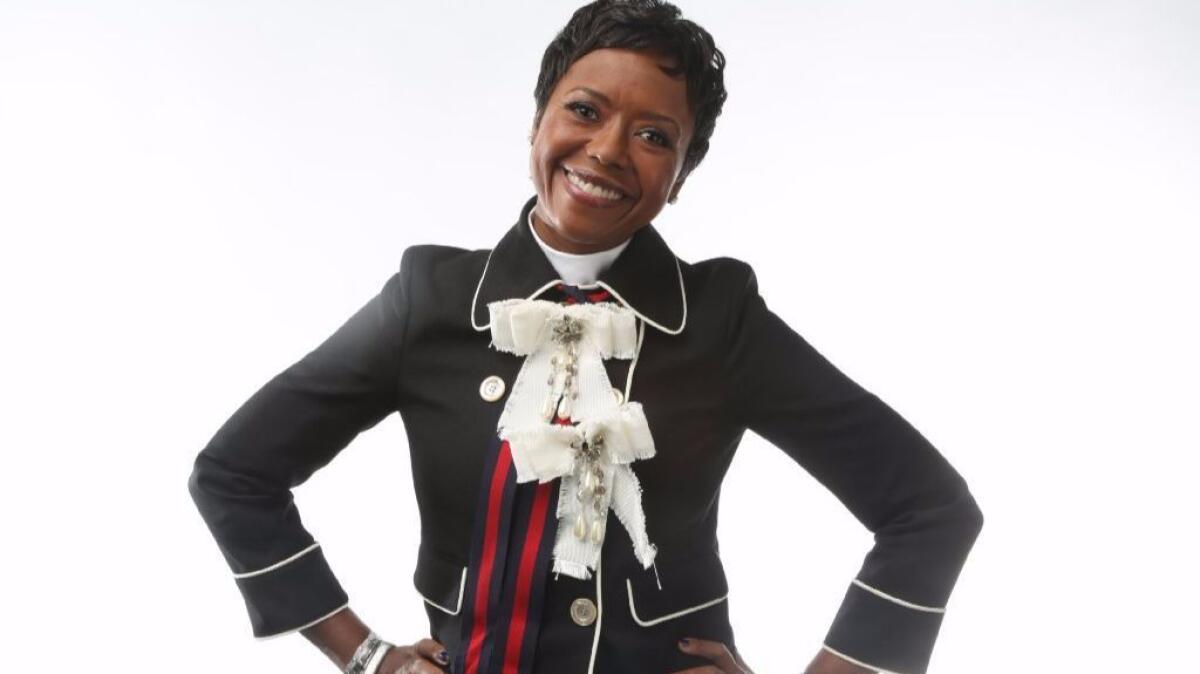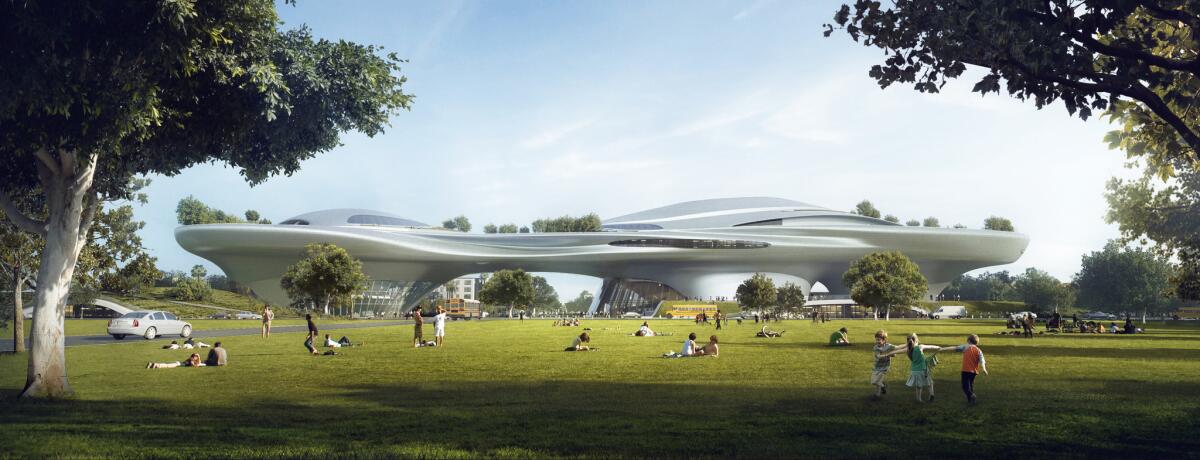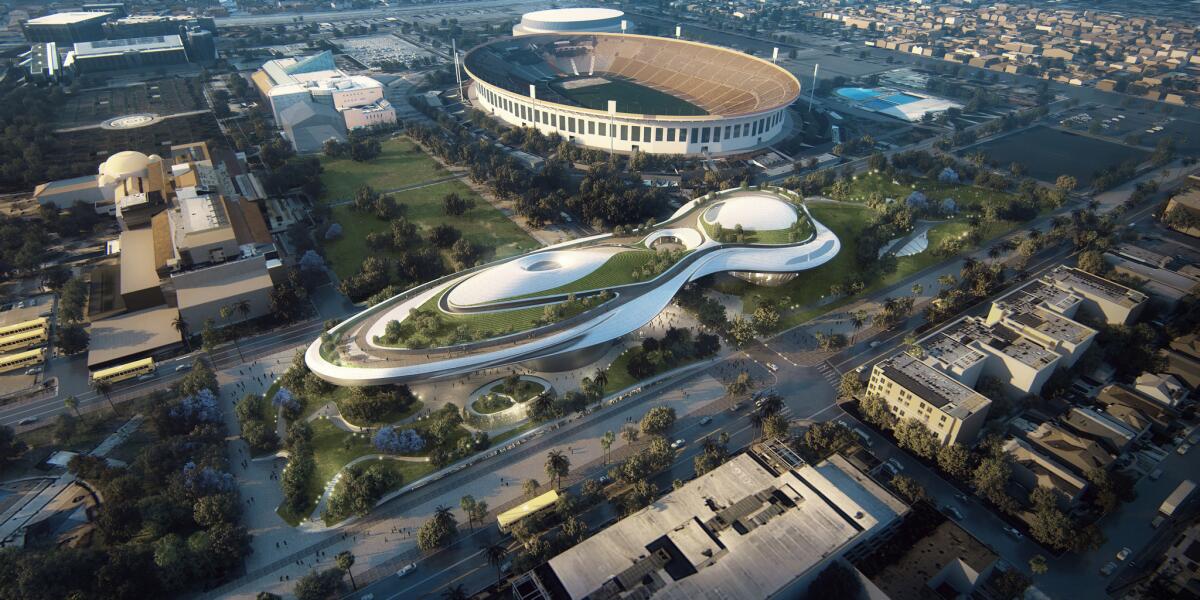George Lucas’ wife, the public voice of his museum, talks about creating ‘something that doesn’t quite exist yet’

When “Star Wars” creator
Lucas’ wife, Ariel Investments President
Through collaboration with nearby schools and USC, the Lucas Museum aims to become an interactive learning center with film screenings, lectures by well known directors, visual artist residencies, a research library and more, Hobson said.
“We’re going to do something very different, it doesn’t quite exist yet,” Hobson said of the museum, which will join the California Science Center, the Natural History Museum of Los Angeles County and the California African American Museum in the park. The rest of the conversation, edited for length:
The Lucas Museum of Narrative Art will bring culture, tourism and tens of thousands of jobs to L.A. It’s clear why the city would want it — but why did the museum want L.A.?
We wanted to be here because of the community. We thought that it was in a community where we could make a difference. It was a community that wanted us, and where our neighbors were world-class museums. A lot of times young people will say to George, “How did you get these ideas?” And he thought it would be great to point to, for example, the Science Center and say, “Go across to the science museum and look at real science, go to the Natural History Museum and look at dinosaurs,” to show where ideas come from.
We also wanted to be here because we’d have so many schools around us, and we saw that we’d have a captive audience, not to mention the tourists that we think will come. You have all of these students who could use this building in the way we envisioned it. I call it a school for schools — this thriving place, almost like a really cool, innovative community centered on this idea of narrative art and storytelling across all of these genres. It could be a place where people come after work, after school, on Saturdays and Sundays. They’d take classes, they’d have the opportunity to interact with famous directors. We said: “This just could be a hotbed of learning and creativity and inspiration.”
Have you talked with the other museums yet about collaborative programming?
We’re not that far along as far as collaborative programming, but we’ve been in conversations with the museums in Exposition Park. And we’ve been on something of a museum tour. We went to Paris and visited everything from the [Fondation] Louis Vuitton to the Paris Cinematheque. George visited the Louvre, Crystal Bridges [Museum of American Art in Arkansas], the New York museums. There’s been a real effort to look at what is happening at museums in the world, put that in context, but also to … do something very different.
Which is what? What’s going to separate the Lucas Museum from other museums you visited? What’s your special narrative?
Our special narrative is accessibility. We want to make sure that a black kid from South-Central is as comfortable in our museum as an art history student who went to Yale or Princeton. Like the Lincoln Park Zoo [in Chicago]: There’s every walk of life there. Our faces are smashed against that gorilla window alongside the family from the Near North, the South Side, the Muslim family — and that was my vision of what this museum is going to look like. We heard about the visitors at [
What also separates us is: Our art is not in most museums, or if it’s there, it’s not exhibited. Norman Rockwell — even though we think of him as a great American artist, in a lot of museums he has not garnered that kind of attention. And it’s this kind of accessibility that we’re trying to bring — not looking down on any art. There’s comic art, there’s pin-up art, there’s photography — there’s a series of Gordon Parks photography that’s breathtaking — and, obviously, “Star Wars” archives and costumes.

What other elements will the museum have?
There will be two screening rooms. Our sense is there will be a cinematheque, so films will be shown every day and that will be a part of the function of the building. There will be artists in residence, a library for research — obviously a great resource for college students, PhD students, high school students. And there will be educational facilities and classrooms that will be used in the furtherance of whatever we might be teaching at that time. Maybe we do a series on digital art, maybe a series on comic art. There’s all sorts of ways this could play out.
Is there a curator yet? And what about other staffing?
The curator hasn’t been hired yet. It’s the seed collection from the Lucas family, and we’ve been acquiring for the last few years, Don [Bacigalupi, museum founding president] has been part of those acquisitions, filling out the collection in areas where he thinks it’s not yet ready for prime time. We couldn’t hire anyone until we knew what city we’d be in! So now there will be a series of hires over the next nine to 12 months.
In terms of permanent jobs, the staff of the museum will be somewhere in the neighborhood of 350 full-time jobs. But the staff itself will be bigger than that in terms of visiting fellows, all sorts of people that come and go in the institution. That probably takes that number up substantially.
How do you define your own role at the museum?
I’m a board member, so I’m a fiduciary. I’m an interested party in obviously the name and reputation of Lucas — because I’m a Lucas, even though I don’t go by Lucas. And I’m the person who I’d say is intensely focused on inclusion. Do we have diverse vendors, diversity in lawyers, any service we’re buying. Building a museum, we’re going to spend a lot of money, and I want to make sure lots of communities can benefit from that spend.
George has been collecting art for four decades. Have you helped to shape his collection at all?
Yes, for sure. I’m thinking of things we’ve bought for our house. We have Kara Walker; we bought a really beautiful series. We bought a really great Chuck Close. We bought Frida Kahlo, which is hard to find, a beautiful Garden of Eden picture. And it’s not that George didn’t like this art, but I don’t think he’d have been as driven to collect it. He had Georgia O’Keeffe, he had Lempicka; when I started dating him, he bought his first Botero, which probably won’t go in the museum, but we’ve collected a lot of Boteros since then, the statues.

Did the current art scene in L.A., or the greater creative community, play a role in the museum’s decision to move here?
I think the art community here means we’re in good company. That was another very attractive thing: L.A. is in a great renaissance right now, it’s very clear. From two football teams to maybe the Olympics to a soccer stadium, what you’ve done with public transportation — it feels like the city is seeing around corners. When we think about the art community in film, clearly the history is here in terms of Hollywood. And when we think about the art community as it’s expanded very, very successfully in Los Angeles, we think about being in good company. The museums are just thriving right now. It’s great to be a part of that.
Do you feel that you’re out of the woods here as far as community pushback?
I want to knock on wood and say: I think we’re out of the woods, I do. We stress-tested this. What could go wrong — we spent a lot of time thinking about that. And we got a lot of assurances, from all areas. It wasn’t just political assurances. It came from the university, from school principals who called me. So I pray that there isn’t something we didn’t foresee. I know this is for the good of society, so I hope there isn’t someone who hijacks it and takes it away from all of us.
The museum’s search for a home has been almost a decade long. Do you and George feel a sense of relief?
This has been a long journey, and there’s a great sense of relief. In this last iteration with San Francisco and L.A., we knew one of those cities was going to work. It wasn’t a question of if, it was which. And so we saw a path to an actual building. And when you think about that compared to the prior two experiences [in San Francisco’s Presidio and along Chicago’s lakefront], where we got close and then got derailed, we didn’t have that kind of comfort or a sense that it was possible. But now we know that it will be built here in Los Angeles, and that is incredibly reassuring and it makes us very, very happy. We’re happy to be in a community that really wants us. That came through loud and clear.
Some people have suggested that you’re the real force behind the Lucas Museum of Narrative Art. Is that true?
No, not at all. Honestly, this museum predates me and my relationship with George. When he built the Letterman Digital Arts Center [in the Presidio], they asked him to put $3 million into escrow for a museum that would be built one day. And they had a site that had already been selected. And they said: “We want you to build that museum.” So he always knew, with that commitment of having been awarded Letterman Digital Arts, that he’d be building a museum.
Then, when I came along and San Francisco was not going well, I did push for Chicago — hard. That was something George really had to get his brain around. Because he never, in his wildest dreams, imagined the museum would be in the Midwest. I thought Chicago was ripe for the opportunity and that we had good relationships. And Chicago presented us with a site that was really great. So maybe that’s where I became a bigger part of that story.
After Chicago was over, I said to George one day, “Should we just be done?” I was really heartbroken over Chicago and said, “Maybe we should stop.” And he was emphatic: ‘This is something I want to do, I’m going to do it, this museum is going to be built, this is a dream, it is going to happen.” And I was like, “OK, we’re building a museum!” My role is to make sure that we do the very best job that we can, but it is George’s vision.
Follow me on Twitter: @debvankin
ALSO
Los Angeles will be home to George Lucas' $1-billion museum
What does building the Lucas Museum at Exposition Park say about L.A.?
George Lucas' museum designs for L.A. and S.F.: A first look at competing plans
Editorial: George Lucas should pick L.A. for his unconventional museum
The biggest entertainment stories
Get our big stories about Hollywood, film, television, music, arts, culture and more right in your inbox as soon as they publish.
You may occasionally receive promotional content from the Los Angeles Times.








